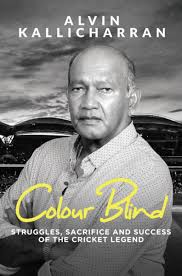Colour Blind
Martin Chandler |Published: 2019
Pages: 229
Author: Kallicharran, Alvin
Publisher: Notionpress
Rating: 3 stars

Alvin Kallicharran is not talked about as an all time great of the game, but he cannot have been very far away from being one. I remember the little man very clearly from my adolescent years and the manner in which he could, on occasion, destroy an opposition bowling attack no matter how strong it was. There was a famous occasion, naturally recounted within the pages of Colour Blind when he put Dennis Lillee, then at his peak, well and truly in his place.
Kalli’s career had a number of interesting features to it. There was a famous incident in the Caribbean in 1974 when he was controversially run out by Tony Greig from the last ball of a day’s play, and then reinstated when play resumed. It may have been almost half a century ago, but it is an incident that clearly still rankles.
Three years later, as did so many of the world’s top players, Kalli signed for World Series Cricket, but then became the first to withdraw. Why? I have heard one or two disquieting theories over the years, foremost amongst them that he was ‘persuaded’ by his English county, Warwickshire, to pull out. If the detail of that story were true it would not reflect well on the county but, disappointingly, the entire episode is simply ignored. It is almost as if the book has a chapter missing.
Later on, and even more controversially, Kalli was also one of the West Indians who was castigated by many for turning out for the so called ‘rebel’ tourists in South Africa. In a slightly different category to some of the other members of the party Kalli had already burnt his boats by playing in South African domestic cricket after some seemingly shabby treatment from the West Indies Board. Kalli does not shy away from his connections in South Africa although in his book, in much the same way as Franklyn Stephenson in his recent autobiography, he chooses to concentrate on what he perceives to be the good that he did in South Africa rather than confront the ideological conflicts which were of much more concern to others.
For years Kalli was a mainstay of a strong Warwickshire side in English summers, and his analysis of what it was like to play seven days a week cricket in England is revealing. His take on English domestic cricket at the time he was a county player is worth reading and, certainly to this reviewer, seems an entirely accurate and reasonable one.
Eventually Kalli ended up in the US and it is in some ways surprising that his story has not been told by the man himself or by a biographer in the past. Certainly it would seem that offers were made but only now, as he passes his three score years and ten, has Kalli decided to go into print. Having done so he makes it quite clear in his introduction that he has not set out to write a conventional autobiography, and in that respect he has succeeded as there is certainly no way that Colour Blind could be pigeon holed in that way. It runs in chronological order, but that is the only similarity with other books of its ilk.
Perhaps the best way to describe the book’s format is to give an example. Chapter 10 is called Indians Rise, and begins with the 1983 World Cup campaign when hot favourites West Indies were beaten in the final by a Kapil Dev inspired India, who most pundits had expected to be the whipping boys of the tournament. Kalli was strictly an observer, his own international career having ended a couple of years previously. No doubt with the book’s release in India in mind Indians Rise then looks at the development of Indian cricket from that point on.
The chapter comprises seventeen pages. There is a summary to set the scene and then a number of separate sections, none more than a couple of pages and some just a short paragraph. Each has a title, and those are:-
Early Warning Signs or Complacency
Indian Success as West Indies Fail to Impress
Firm Foundations
Role Models – Sunil Gavaskar – Focus, Concentration and Self-Belief
Gundappa Viswanath – Sportsmanship
Mohinder Amarnath – Bravery and Resilience
Sachin and Beyond
Admiration Awareness
Fitness
Trust and Depth
Colour Blinded by Green
Grateful Ground Roots
Balance and Planning
Balanced Attack – Future Speedsters
Opportunity and IPL
Reflect on Success
Like each of the other chapters in the book Kalli then concludes with a short Reflections and Summary, some soundbites of advice for his reader (described as Key Takeaways) and some suggestions as to a way ahead (described as Action Steps)
I have to say that, overall, I enjoyed Colour Blind, which is an interesting story that certainly succeeds in providing plenty of insight into Kalli’s life and career. It is however hampered by a disappointing selection of photographs and the absence of an index or any sort of statistical summary and, of course, that omission from the story that I highlighted earlier. On the other hand it is to the writers’ credit that, despite Kalli clearly having turned to religion later in life and certainly making that very clear in the book, he does not preach to the non-believer in the irritating manner that some who discover their God late in life do. There are some passages that could be described as somewhat sanctimonious but, ultimately, it is Kalli’s book and whilst some of his messages will irritate some of his readers I can’t imagine that too many will be putting the book down.






Leave a comment